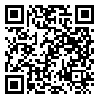Volume 9, Issue 33 (2016)
LCQ 2016, 9(33): 21-51 |
Back to browse issues page
Download citation:
BibTeX | RIS | EndNote | Medlars | ProCite | Reference Manager | RefWorks
Send citation to:



BibTeX | RIS | EndNote | Medlars | ProCite | Reference Manager | RefWorks
Send citation to:
Algooneh Juneghani M. A study on the analytic capacity of the semiotic square in reading poetry. LCQ 2016; 9 (33) :21-51
URL: http://lcq.modares.ac.ir/article-29-2950-en.html
URL: http://lcq.modares.ac.ir/article-29-2950-en.html
Assistant Professor, University of Isfahan
Abstract: (9092 Views)
Semiotic Square, as a model trying to analyze and explain the foundation of signification, was firstly developed by Greimas. This model is the logical outcome of the development of binary oppositions, and is based on the primary structure of signification. It was first used in the structural analysis of narratives. However, Greimas, Rastier and some other members of Paris school applied it in the field of semiotics of poetry, as well. Nevertheless, researches using this model in the field of Persian literature are mainly concerned with its application in the structural analysis of either prose or verse narratives, and as a consequence, there is no comprehensive research which analyses the process of signification in poetry according to this model. Hence, after providing the basic assumptions of semiotic model, the present article tries to apply it in a semiotic reading of poetry. Therefore, at first the basic components of semiotic square and their combination methods is explained and afterwards the internal organization of the components of a poem by Attar, Mowlavi, and Hafiz is respectively analyzed. Such a research not only provides the possibility of the analysis of the poem's structure, and brings forth some of its latent perspectives, but also offers a reader-oriented model which indicates how a potent reader recognize and categorize the semantic components of the poem so as to arrive at a better understanding.
Article Type: Theoretical |
Subject:
Street literature
Received: 2015/10/26 | Accepted: 2016/05/7 | Published: 2016/06/21
Received: 2015/10/26 | Accepted: 2016/05/7 | Published: 2016/06/21
| Rights and permissions | |
 |
This work is licensed under a Creative Commons Attribution-NonCommercial 4.0 International License. |








